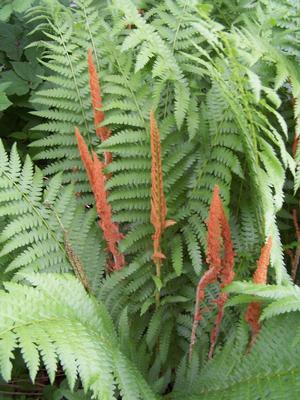View All Plants :: View All FERNS :: View All POND & WETLAND PLANTS :: View All SHADE PERENNIALS
Osmunda cinnamomea
Cinnamon Fern
Plant Type:
FERNSOsmunda cinnamomea – The golden brown feather “inflorescence” (really a stylized fertile frond) matures to dark brown. This feature plus the brown hirsute nature of leaf stems are the inspiration for its common name, Cinnamon Fern. Osmunda cinnamomea will slowly increase its numbers in an effort to form a handsome colony. According to the CT Botanical Society “its fiddleheads are food for ruffed grouse, and hummingbirds sometimes use the fuzz on young fronds to line their nests.” The silvery “fuzz” on all new, unfurling fiddleheads is a favorite nesting material for many species of birds in many parts of this species broad range. Part sun to open shade in fertile moisture retaining soil. Native to all of eastern North America, all states bordering west of the Mississippi River plus Minnesota, Oklahoma and Texas. Cinnamon Fern is often found growing on stream banks and in bogs and swamps. Pot grown Division. Scroll down to the Genus Overview for more purple prose about ferns.
Characteristics and Attributes for Osmunda cinnamomea
Season of Interest (Foliage)
- Spring / Summer / into Autumn
Nature Attraction
- Deer Resistant
Light
- Morning Sun / Afternoon Shade
- Dappled Shade
- Shade
Attributes
- Marginal
- Foliage
- Cutting Garden
- Massing
- Woodland
- Specimen
Growth Rate in the Garden
- Moderately Fast
Soil
- Fertile
- Moist
Origins
- North America
Propagated By
- Division
Genus Overview: Ferns
Ferns. The easy, elegant and exceptional beauty of ferns cannot be understated. All ferns, beautiful as specimens unto themselves, are extraordinary in their simple ability to provide rich contrast to other companions wherever their requirements befit.
Habituated to so many environments many of the ferny pteridophytes – vascular plants that reproduce by spores, not seeds - are woodland denizens thriving on the cool, damp forest floor like the Christmas Fern, Polystichum acrostochoides with some preferring the wetter disposition of bogs, swamps, and stream banks such as Osmunda cinnamomea. Others will colonize gritty soils in shade or sun like the running Hay-scented fern, Dennstaedtia punctilobula and many among the Cheilanthes. Some are tough enough to grasp a foothold in the crack of a rock, these are lithophytic, as with Asplenium trichomanes. And some – most of these tropical in origin are truly epiphytic, clinging to tree bark as they unfurl their fronds from embryonic croziers to reach into the forest light such as the primitive looking Staghorn Fern, Platycerium bifurcatum or Rabbit-foot Fern, Davallia fejeensis .
And many have historic medicinal uses such as Maidenhair Fern, Adiantum pedtaum – this from medicinalherbinfor.org, “Expectorant, anti-rheumatic, demulcent, pectoral, refrigerant, tonic”... Native Americans throughout North America used maidenhair as a hair wash to make their hair shiny.” And in a more Bacchanalian use: as a flavoring in liquers.
There was probably something fern-like, an ancient ferny forebear(s) if you will, living during the Devonian some 60 to 70 million years ago. Ferns, some we still recognize today are descendents from an ancient order whose reign during the Carboniferous Age is legend, where giant horsetails and monstrous club mosses still populate the misty recesses of our dreams... and whose contemporary plundering by Homo sapiens in the vast burning of fossil fuels is altering our climate at such an alarming rate that more among the many are beginning to query as to the potential for another mass extinction – the closing chapter of another age, a blip in the larger context of perceived time. But I digress....
All our offerings are well-rooted pot grown divisions in 5 pint squares unless otherwise indicated. The quality we offer make them worth the money. We think you will agree.


